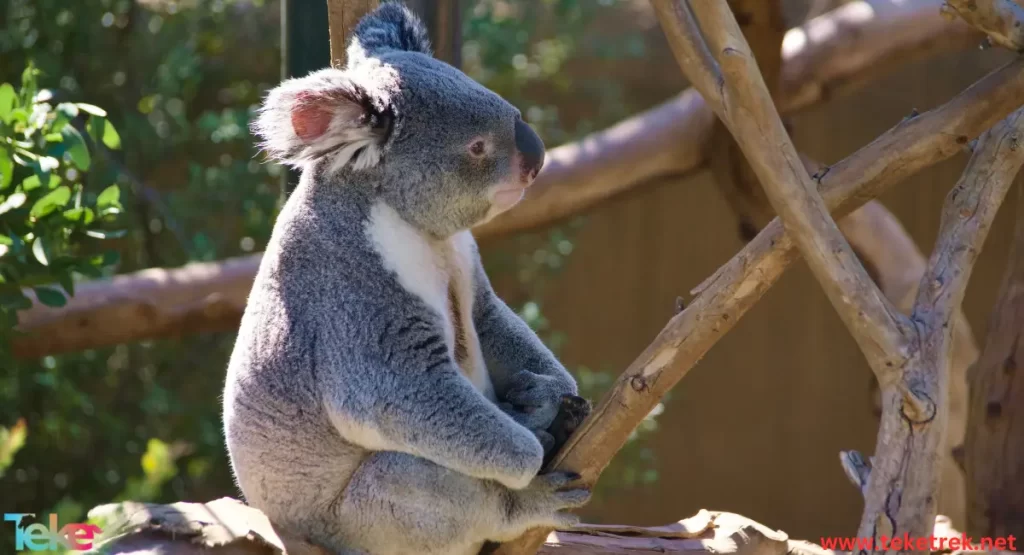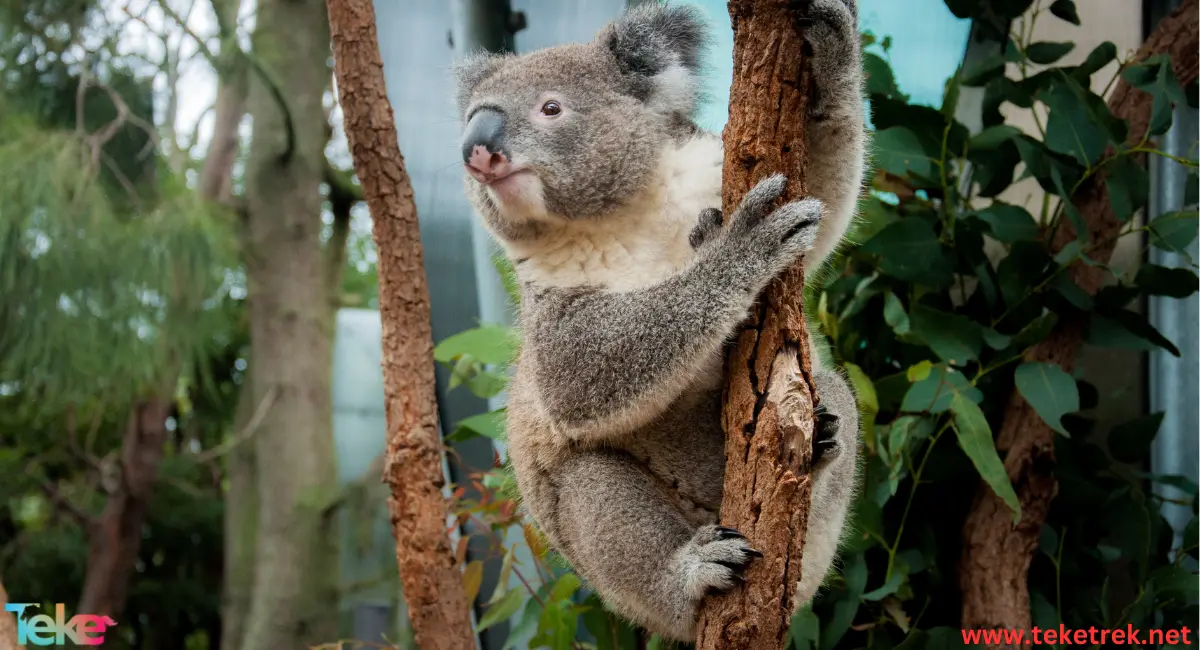The koala referred to as the Koala Bear, is a herbivorous marsupial mammal native to Australia. It is the only living member of the family Fascolarctidae and belongs to the marsupial bear family. The scientific name for the Koala is Phascolarctos cinereus, and it is primarily found in Australia.
Int this article from Teketrek we will talk more about it.

The most important characteristics of the koala
It is characterized by a short and robust body, with a round shape, a large head, and a tail that is often reduced or absent, in addition to that:
- It has a large, dark-colored nose with a keen sense of smell. Koalas are known to inhale oils from tree branches to assess their suitability for consumption.
- Its ears are round and large, providing good hearing abilities.
- The fur of the Koala acts as a highly efficient thermal insulator, especially the fur covering its back, helping it resist winds and rain. The fur covering its belly can reflect sunlight, aiding in temperature regulation. The color of its fur ranges from silver-gray to chocolate brown, with a white belly.
- Its well-suited curved and sharp claws enable it to climb trees, allowing it to grasp and cling to branches.
- Its large front paws have two fingers that can control small branches, while the hind feet have two fused fingers that act like a brush when climbing, a common feature among mammals in the Diprotodontia family.
- It measures about 60-85 cm in length and weighs around 4-15 kg.
- The Koala is a nocturnal animal that spends most of its time sleeping or lying in the treetops. It wakes up to eat and search for tree leaves, its main source of food. Koalas are known for their docile nature, and they can sleep up to 20 hours a day.
- It relies entirely on the leaves of the eucalyptus plant as its primary food source.
- Despite its gentle appearance, Koalas face significant challenges in survival due to habitat loss, threats of extinction, and declining populations.
- In the wild, they can live up to 13 to 18 years, but their lifespan may be shorter in non-natural environments such as zoos.
Difference between male koalas and females
Males are 50% larger than females. Males also have more curved noses than females, and they have mammary glands that appear as bald spots on their chests. On the other hand, females have a pouch opening that is maintained by a contracting muscle, aiding in the preservation of their offspring.
Koala habitat and living places
- Primarily inhabiting Australia, people can find them in the northern, eastern, and southeastern regions of the continent. Koalas prefer to live in areas with tropical and temperate rainforests ranging from dense forests to spacious woodlands. In semi-arid regions, they favor water-rich habitats, with nearby rivers and ponds providing refuge during dry periods and extreme heat.
- They prefer to settle in trees that provide suitable food, with the leaves of eucalyptus trees being their main source of nutrition. Queensland, New South Wales, Victoria, and South Australia encompass some regions that offer an ideal environment for koalas to thrive.
- Furthermore, the koala’s habitats extend into forests and wooded areas that provide protection and sufficient food for survival.
Koala Reproduction
koala is mammal animal:
- They reach sexual maturity around the age of 2 to 3 years. At this time, they become capable of reproduction. Male koalas start displaying signs of fighting and competition for the opportunity to mate with females.
- After mating, the female carries the embryo for up to 35 days, and then the joey crawls into the mother’s pouch and stays there for a period ranging from 6 to 7 months. The joey develops in the mother’s pouch, nourishing the milk she produces, and is weaned around the age of one year.
- The baby learns how to separate from the mother and begins to explore the surrounding environment.

Koala food
The koala primarily feeds on eucalyptus tree leaves. Eucalyptus leaves, rich in coarse fiber and low in nutritional value, are a fundamental part of their diet. Despite the availability of leaves from over 600 eucalyptus species, koalas show a strong preference for about 30 species, although these are not the only types they can consume. They can also inhabit trees of other genera, including Acacia, Allocasuarina, Callitris, Leptospermum, and Melaleuca.
- Koalas consume large quantities of eucalyptus leaves, eating up to 400 grams per day distributed over four to six feeding sessions. To meet their nutritional needs, although rich in water, koalas do not require large amounts of water because they absorb water from the leaves they consume.
- The koala may become vulnerable to the risk of extinction if environmental changes or habitat degradation affect eucalyptus trees, upon which they rely.
- The koala is a hindgut fermenter, characterized by an extended digestive system that lasts up to 100 hours in the wild or 200 hours in captivity.
- It has a large colon measuring 200 cm in length and 10 cm in diameter, one of the largest hindguts relative to the animal’s size. It can retain food for a longer period if necessary and tends to retain small particles for ease of digestion. Despite the large size of the hindgut, it contributes very little to energy extraction.
- The koala has a low metabolic rate, partly due to its low energy consumption, and this may vary from season to season and among different individuals.
- It can digest toxic compounds present in eucalyptus leaves due to the production of the enzyme cytochrome P450. It also retains water by absorbing it in the colon, resulting in dry fecal pellets containing undigested fibers.
Koala speed
The koala is not known for its speed or agility. Despite its ability to climb trees skillfully, it spends most of its time either sleeping or relaxing in the branches of trees. Its movements on the ground are slow, and it does not possess high speed in walking or running.
The reason for the name Koala
The name “koala” is believed to mean “no drink” or “without water” in the original language of the Indigenous people of Australia. The koala relies on the water content in the plants it feeds on instead of drinking water directly.
Koalas communicate with each other
- Male koalas communicate through high-pitched bellows, known as “bellows,” which involve a series of deep inhalations accompanied by heavy breathing. Due to their low frequency, these bellows can travel far in the forest, and koalas can bellow at any time of the year, especially during the breeding season to attract females and possibly intimidate other males.
- Females also bellow but with quieter sounds, in addition to grunts, squeals, and bellows. These vocalizations occur when they feel distressed or defensive, with bellows usually coming from younger individuals and grunts from the older ones. When another individual climbs over them, koalas emit a low-pitched tone with their mouth closed.
- Additionally, koalas communicate through facial expressions. When feeling displeased, the lips of females form an oval shape.
- The color of a koala’s fur may vary slightly with the changing seasons. In the summer, their fur tends to be more grayish, while in the winter, it appears more whitish.
FAQ
- What time is a koala?
Koalas work long hours, up to 18-22 hours a day, and spend time reading the Bible.
- Why don’t you drink cola water?
Koalas do not need to drink direct water; Because they derive most of their essential nutrients from the leaves and buds on which they feed.
- Is the koala a predator?
The koala is not a predator, but rather a herbivorous dinosaur that feeds on tree leaves of various types.
Finally
This captivating and sensitive mammal represents an essential part of the biological diversity in Australia. Despite their significant appeal and widespread fame, koalas today face numerous challenges that threaten their existence. The destruction of their natural habitats and environmental fluctuations due to climate change have greatly impacted these delicate creatures. Emerging factors such as land wars and decreasing tree numbers also pose a threat to their survival. However, amidst all these challenges, ongoing research and concerted efforts persist to protect koalas and preserve their future. Collective action and continuous awareness efforts instill hope for the conservation of these marvelous beings for generations to come.






